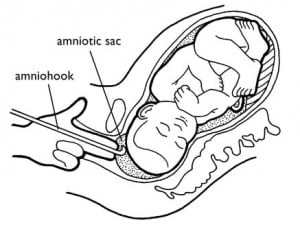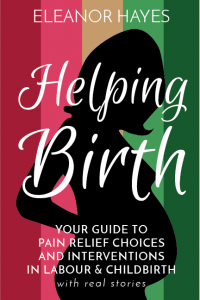Birthzang’s Guide to Medical Induction of Labour
Image: mybirth.com.au[/caption]
So you have exhausted all natural methods to induce labour, you have waited patiently for your baby to arrive, read my blog about risks of induction, and finally you have decided to opt for a medical induction of labour. But what does this mean? What actually happens when you have an induction? How long does an induction of labour take? What should you expect?
During your 40-week appointment, your midwife may well offer you a vaginal examination to see how “ripe” your cervix is, and whether you are dilated at all. This is known as the Bishop Score and is a point scoring system based on the position, hardness and stretchiness of the cervix, how open it is (dilated) and the position of the baby’s head in relation to the cervix. [1]
This will shape the rest of the process. An unripe cervix is thick, closed, and hard – around 3cm wide and around 6cm deep. A ripe cervix will be very soft and will have started opening (dilating), and also start to thin (when it is fully dilated in labour it will be paper thin and 10cm open).
If your cervix is ripe and a tiny bit dilated, your midwife will be able to offer you a membrane sweep. Different hospitals will have different policies on this and you may be offered a sweep before 40 weeks, and have 2, 3 or even 4.She will insert a gloved finger into your cervix, up into your uterus, until she can feel the membranes surround the baby. She will “sweep” her fingers in a circular motion to help separate the membranes from the uterus to stimulate the entire area. It can be a little uncomfortable but shouldn’t be painful.
For many women, a sweep is just enough to give their labour a kick-start. In the next 24 hours, you may well experience slight cramping and spotting, your waters may break, and contractions may start…or, perhaps nothing!
If this doesn’t work, then induction of labour is the next step but this is not a straight-forward process and takes the form of 4 stages, some of which can be walked away from, but once you reach a certain level of the induction process you will not be able to go back.
Before you even start…
Arriving at hospital
You will be booked in to go to the hospital at a specific time – usually first thing in the morning – but this doesn’t mean it all starts then. Most hospitals will ask you to ring the labour ward before coming in case they are busy and full – you will only be admitted if there is a bed available at that moment.
Initial Assessment (1-2 hours, plus waiting)
On arrival at the hospital, you will be assessed by a midwife. This usually involves a vaginal examination to work out your Bishop Score, and then a short period (20-30 mins?) of monitoring your baby’s heart rate. They will probably take your blood pressure, temperature, have a urine sample so they can assess your health as well.
The Bishop score will indicate how ready your body is to labour and will allow the midwife to assess at what stage in the induction process they can start. They will then put together a treatment plan.
The monitoring will act as a baseline level to show what the baby’s heart rate is in a normal, relaxed environment – basically what a happy baby’s heart rate looks like. You have to be constantly monitored during an induction of labour, but more about that in a minute.
Now, assuming they are happy to go ahead with the induction, they will admit you to the hospital. Well, that is, if they have space. Perhaps between phoning this morning, driving to the hospital, parking, finding the maternity unit, waiting to be assessed, and being assessed, there are now no beds available!
If this is the case you may be asked to wait in a waiting room (take plenty of pillows!), or even go home and wait for them to call you! Some hospitals will phone in the evening and ask you to come in at 10pm so start the induction process. Of course, you have to decide whether you value a good night sleep more than the start of labour!
Once you get a bed in the hospital you will be admitted. You will be taken to a room or a ward and start the induction process.
Natural Ways to Induce Labour

Available as kindle or papaerback on Amazon now.
Stages of Induction of Labour
1. Prostaglandin gel/pessary (up to 24 hours)
The initial part of an induction of labour is the use of prostaglandin to help ripen your cervix. Prostaglandin is a hormone that is released at the start of labour. This artificial version is inserted directly on to the cervix either via a pessary (called Propess) or a gel.
The pessary is a bit like a tampon. You have to lie down for 30 mins while it expands but after that you are left to your own devices for up to 24-hours before it is removed, although as soon as labour appears to start it will come out so could be much sooner. [2] The gel will be applied to the cervix and then reapplied after 6 hours if nothing has happened. After 2 applications they will go to the next stage. You will probably have monitoring at intervals but basically, you can walk around, go to sleep, leave the room. You will not be allowed to go home though.
Hopefully, the pessary with either start contractions, or at the least ripen your cervix more so that a little bit of dilation occurs. If nothing has happened you could, in theory, go home at this point and just wait for things to happen naturally (unless you have been advised to have an induction for medical reasons – being overdue is not, in itself a medical reason).
2. Artificial Rupture of Membranes (up to 2 hours)
Once your cervix has ripened then you will be able to move onto the next stage in the process and have your waters broken or ARM. Hospitals vary in policy and will break your waters either at this point, or may wait until later on it the labour. In my local hospital (Royal Berkshire Hospital, Reading, UK) they do it at this stage. [3]
A long hook is inserted into the vagina, through the cervix – it has to be a little bit dilated to do this -and the membranes are nicked to break them. There will be water, quite a lot of it, and it may continue to leak throughout labour.
Once your waters have been broken you will not be able to leave the hospital, and the induction “clock” starts ticking. Some midwives, particularly if you are not on your first birth, may allow you an hour or two to see if this is enough for contractions to start naturally. You will have to request this and may well have to have the agreement of a consultant. [4]
You do not need to be continuously monitored if this happens. (As an aside, I had ARM with my second labour and it was enough to start contractions so I was able to avoid any further intervention.) If contractions do start in these 2 hours you may well find your medical team still wish to use further interventions but it is still up to you to decide whether to let the labour continue naturally or to help things along.
Breaking the waters means the baby’s head connects very strongly with the cervix which helps stimulate labour hormones and contractions. If done during labour, it can increase the intensity of contractions because of this.
3. Oxytocin drip (up to 12 hours)
We have finally reached the actual “induction” part of the process – the pitocin drip. At this point you will be given a cannula (needle) in your hand to administer the drug. You may be asked to take a cannula at the same time as ARM but if you have opted to wait for 2 hours then you can also request to wait for the cannula to be inserted. In my own experience, I had to be very firm about this!
Make sure you ask for the cannula to be inserted into your wrist or even lower arm so you can still use your hands to help you get into good Active Birth positions (upright and leaning forwards).
Once the cannula is in, the artificial oxytocin hormone – Pitocin – will be administered. This will kick-start your labour and cannot be switched off until the baby is born. The pitocin stimulate contractions but as it is being done artificially your body cannot regulate the intensity of the contractions. You could ask to be started off at the lowest dose to see if that is enough to start labour. [5]
Contractions stimulated in this way are often more intense and more painful than natural contractions and being upright and leaning forwards will really help you cope with the pain. Avoid lying on your back on the bed as it will not help your body and may well make the contractions more painful than they need to be.
You will now need to be continually monitored – one device will monitor your contractions and the other will monitor your baby’s heart rate. If your baby’s heart rate starts increasing then the pitocin dose may be lowered.
You will be expected to dilate fairly rapidly – 1cm per hour – and will have regular assessments to check your progress. You may wish to have pain relief to help. Keeping the room dark and having minimal interruptions can help the body start catching up with the artificial process.
Once your baby is born, you will be given a further shot of pitocin to encourage the placenta to deliver. [6]
Induction of labour failure
If after a certain period of time the labour is not progressing satisfactorily, or the baby is getting distressed, you may find that you are advised to have, or need to have a caesarian birth.
My Book: Helping Birth
Helping your body catch up after Birth…
Induction is a process managed by artificial hormones. Unsurprisingly they interrupt the normal and natural hormone process that starts in labour and continues once the baby is born. There are things that you can do to encourage your body’s own oxytocin to catch up which will help with bonding with your baby and establishing breastfeeding.
- Delayed cord clamping – up to 4 minutes after birth the baby will receive up to 30% more blood. [7]
- Skin-to-skin and eye contact with baby – this helps stimulate natural oxytocin which aids bonding & breastfeeding. As much as possible in the first few weeks. [8]
And most importantly, enjoy the fact your baby is now with you!
To learn more about pain relief options and common interventions in birth – including induction – and how to maintain a positive active birth, come to a Birthzang Active Birth, Pain Relief & Interventions Workshop.
References
[1] Bishop Score, according to Wikipedia.
https://en.wikipedia.org/wiki/Bishop_score
[2] Prostaglandin, and also a guide to induction.
https://www.babycentre.co.uk/a173/induced-labour
[3] Artificial Rupture of Membranes, and the induction process at Royal Berkshire Hospital.
https://www.royalberkshire.nhs.uk/pdf/Induction.pdf
[4] Waiting after ARM before starting induction.
https://www.fastbleep.com/medical-notes/o-g-and-paeds/16/35/451
[5] Pitocin drip for induction.
https://pregnancy.about.com/od/induction/f/pitocin.htm
[6] Pitocin to deliver placenta.
https://www.ncbi.nlm.nih.gov/pmc/articles/PMC3057346/
[7] Delayed cord clamping
https://cord-clamping.com/
[8] Skin-to-skin
https://www.nbci.ca/index.php?option=com_content&id=82:the-importance-of-skin-to-skin-contact-&Itemid=17
[9] NICE guidelines for Induction
https://www.nice.org.uk/nicemedia/live/12012/41255/41255.pdf





